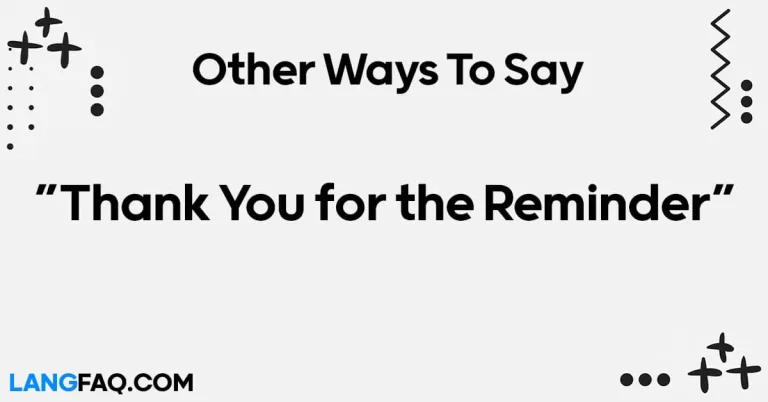In the realm of effective communication, the phrase “I would like to bring to your attention” holds a crucial place. Understanding the impact of language and exploring alternatives is vital for fostering positive relationships and professional success. This article delves into 12 distinct ways to convey importance, offering a toolkit for mastering the art of expression.
12 Other Ways to Say “I Would Like to Bring to Your Attention”
Here are 12 alternatives to “I would like to bring to your attention”:
- Highlighting
- Noting
- Emphasizing
- Spotlighting
- Drawing Your Focus to
- Pointing Out
- Bringing to the Forefront
- Noteworthy Point
- Shedding Light On
- Flagging
- Underscoring
- Directing Your Attention to
| Expression | Meaning | Example |
|---|---|---|
| Highlighting | Emphasizing the importance or significance | “Allow me to highlight the key aspects of the proposal.” |
| Noting | Acknowledging and drawing attention | “I’m noting a critical update in the project timeline.” |
| Emphasizing | Giving special importance or focus | “I want to emphasize the impact of this decision on our team.” |
| Spotlighting | Placing in the spotlight for emphasis | “This report is spotlighting the success stories from our recent campaign.” |
| Drawing Your Focus to | Guiding attention towards a specific point | “I’m drawing your focus to the new guidelines we need to follow.” |
| Pointing Out | Indicating or bringing to notice | “Allow me to point out the potential challenges we might face.” |
| Bringing to the Forefront | Placing at the forefront of attention | “This issue needs addressing; let’s bring it to the forefront of our discussion.” |
| Noteworthy Point | Identifying a point of particular importance | “Before we proceed, let me share this noteworthy point from the research.” |
| Shedding Light On | Providing clarity or insight | “Shedding light on the details, this strategy aims for long-term sustainability.” |
| Flagging | Marking as important or raising awareness | “I’m flagging the potential risks associated with this decision.” |
| Underscoring | Emphasizing or underlining the significance | “Underscoring the urgency, we need everyone’s cooperation in meeting the deadline.” |
| Directing Your Attention to | Guiding focus towards a specific matter | “Directing your attention to the financial report, there’s a notable increase in profits this quarter.” |
Mastering alternative expressions to “I would like to bring to your attention” allows for dynamic and effective communication. Each phrase brings its own nuance, enabling individuals to tailor their language for diverse situations and audiences, fostering clearer and more impactful dialogue.
Is It Correct to Say “I Would Like to Bring to Your Attention”?
Absolutely, saying “I would like to bring to your attention” is a correct and formal way to draw someone’s focus to a specific matter. This phrase is commonly used in professional settings, written communication, and formal discussions to politely highlight important information or issues.
Here are a few points to consider:
- Formality: The expression is considered formal and professional, making it suitable for business emails, reports, meetings, or any situation where a level of formality is expected.
- Politeness: It carries a polite tone, indicating that the speaker is approaching the matter with respect and courtesy, rather than being overly direct or demanding.
- Clarity: The phrase is clear and straightforward, leaving no room for ambiguity about the importance of the information being presented.
Example Usage:
- “I would like to bring to your attention the upcoming changes in our project timeline. Please review the attached document for details.”
Variations:
- You can also use alternatives like “I wish to highlight,” “May I draw your attention to,” or “Allow me to point out” for a slight variation in expression while maintaining a formal tone.
Professional Mail Example With “I Would Like to Bring to Your Attention”
Subject: Urgent: Project Timeline Update
Dear [Recipient’s Name],
I trust this email finds you well. I am writing to bring to your attention an important update regarding our ongoing project.
I would like to bring to your attention that, after a thorough review, we have identified a critical adjustment needed in the project timeline. This modification is crucial for ensuring the successful completion of our deliverables within the set deadlines.
To provide you with more details, I have attached an updated project timeline document to this email. It outlines the specific changes and adjustments we are proposing to maintain the project’s efficiency and quality.
I understand the significance of adhering to our project schedule, and I am confident that with this adjustment, we can mitigate potential risks and enhance our overall project management strategy.
Your expertise and insights on this matter are highly valued. Therefore, I kindly request you to review the attached document at your earliest convenience. Should you have any questions or require further clarification, please do not hesitate to reach out.
We plan to discuss this adjustment in our upcoming team meeting scheduled for [Date and Time]. Your participation and input during the meeting will be crucial as we collectively navigate this modification.
Thank you for your attention to this matter. I appreciate your commitment to the success of our projects and look forward to our continued collaboration.
Best regards,
[Your Full Name] [Your Position] [Your Company] [Your Contact Information]
Highlighting: Emphasizing Importance with Precision
In the intricate dance of communication, the word “highlighting” serves as a beacon, directing attention with precision. This expression is versatile, allowing you to underscore crucial details without overwhelming your audience.
Scenario: In a professional context, when presenting a proposal, you can use “highlighting” to draw attention to key aspects. For instance, “Allow me to highlight the key elements of the marketing strategy.”
Example Sentence: “During the meeting, I will be highlighting the innovative features of our upcoming product release.”
Email Sample:
Subject: Highlighting Key Points for Upcoming Presentation
Dear Team,
As we prepare for our presentation next week, I’ll be highlighting the crucial components of our market analysis. Please review the attached document for a sneak peek. Looking forward to our discussion.
Best regards, [Your Name]
Variations:
- “Spotlighting”: When you want to add a touch of theatricality, emphasizing importance as if under a spotlight.
- “Pointing Out”: More casual, suitable for discussions among colleagues or friends.
Noting: Acknowledging and Directing Attention
When finesse is required in bringing something to notice, the term “noting” steps forward. It combines acknowledgment with guidance, making it ideal for various settings.
Scenario: In a formal meeting, you can use “noting” to acknowledge a critical update. For example, “I’m noting a significant adjustment in our project timeline.”
Example Sentence: “Before we proceed, I want to note the impressive efforts put in by our team during this challenging project.”
Email Sample:
Subject: Noting Progress and Milestones
Dear Team,
I am noting the outstanding progress we’ve made in the last quarter. Please find attached a detailed report highlighting our achievements.
Best regards, [Your Name]
Variations:
- “Drawing Your Focus to”: Adds a personal touch, guiding attention more explicitly.
- “Pointing Out”: A slightly informal alternative, suitable for team discussions.
Emphasizing: Giving Special Weight to Your Message
In the tapestry of communication, “emphasizing” is the brushstroke that adds depth. It infuses your message with significance, making it a valuable tool in conveying importance.
Scenario: In a formal presentation, you might use “emphasizing” to stress a critical decision. For example, “I want to emphasize the importance of adhering to the new company policy.”
Example Sentence: “As we move forward, emphasizing the need for collaboration will be essential for project success.”
Email Sample:
Subject: Emphasizing Team Collaboration
Dear Team,
I’m emphasizing the significance of collaboration in our upcoming project. Let’s schedule a brief meeting to discuss how we can integrate our efforts seamlessly.
Best regards, [Your Name]
Variations:
- “Underscoring”: Adds a layer of intensity, ideal for more serious contexts.
- “Shedding Light On”: Suitable for situations where clarity is essential, allowing you to explain intricacies.
Spotlighting: Placing Importance in the Limelight
When you want to add a touch of drama to your communication, “spotlighting” is the phrase to employ. It places importance in the limelight, making your message stand out with theatrical flair.
Scenario: In a creative brainstorming session, you might use “spotlighting” to draw attention to innovative ideas. For example, “This concept is spotlighting the potential for groundbreaking creativity.”
Example Sentence: “As we explore new avenues, spotlighting unconventional solutions will be our key focus.”
Email Sample:
Subject: Spotlighting Creative Ideas
Dear Team,
Our next meeting is dedicated to spotlighting fresh, creative ideas for our upcoming campaign. Please come prepared to share your innovative suggestions.
Best regards, [Your Name]
Variations:
- “Highlighting”: A more straightforward alternative, suitable for formal presentations.
- “Bringing to the Forefront”: Adds a layer of formality, ideal for professional discussions.
Drawing Your Focus to: Guiding Attention with Subtlety
For a more nuanced approach to directing attention, the phrase “drawing your focus to” proves invaluable. It guides without imposing, making it apt for various communication contexts.
Scenario: In a team meeting, you can use “drawing your focus to” to gently guide attention. For example, “I’m drawing your focus to the upcoming changes in our workflow.”
Example Sentence: “While discussing the project, drawing your focus to the collaborative aspect will be beneficial for team dynamics.”
Email Sample:
Subject: Drawing Your Focus to Workflow Adjustments
Dear Team,
In our next meeting, we will be drawing your focus to the adjustments in our workflow. Your insights on this matter are highly appreciated.
Best regards, [Your Name]
Variations:
- “Pointing Out”: A more straightforward alternative, suitable for casual discussions.
- “Directing Your Attention to”: Adds a layer of formality, fitting for professional settings.
Pointing Out: Indicating with Clarity
In the realm of effective communication, “pointing out” is a versatile phrase, allowing you to indicate or bring attention to specific details with clarity.
Scenario: In a collaborative project, you might use “pointing out” to draw attention to potential challenges. For example, “Allow me to point out the risks associated with this decision.”
Example Sentence: “While discussing the budget, pointing out potential cost-saving measures will contribute to our financial sustainability.”
Email Sample:
Subject: Pointing Out Key Considerations
Dear Team,
In our upcoming meeting, I’ll be pointing out key considerations for our next project phase. Your input on these matters is crucial.
Best regards, [Your Name]
Variations:
- “Noting”: A more formal alternative, suitable for professional discussions.
- “Bringing to the Forefront”: Adds formality, ideal for presentations or reports.
Bringing to the Forefront: Placing Importance Center Stage
In the symphony of communication, “bringing to the forefront” is the conductor’s cue to place significance center stage. This phrase adds a layer of formality, ideal for professional discussions and presentations.
Scenario: In a boardroom setting, you might use “bringing to the forefront” to emphasize a critical agenda item. For instance, “This report is bringing to the forefront the financial projections for the next quarter.”
Example Sentence: “As we delve into the strategic plan, bringing to the forefront the key milestones will guide our decision-making process.”
Email Sample:
Subject: Bringing to the Forefront – Financial Projections
Dear Team,
Our next meeting will be bringing to the forefront the financial projections for Q3. Please review the attached documents in preparation.
Best regards, [Your Name]
Variations:
- “Spotlighting”: If you want to add a touch of dramatic emphasis.
- “Noteworthy Point”: For a more nuanced alternative, suitable for both formal and informal contexts.
Noteworthy Point: Identifying a Point of Significance
When you aim to label a specific detail as particularly noteworthy, the phrase “noteworthy point” becomes your linguistic ally. This expression works seamlessly in both formal and informal communication.
Scenario: During a team discussion, you might use “noteworthy point” to draw attention to a significant achievement. For example, “Before we proceed, let me share this noteworthy point from the latest market analysis.”
Example Sentence: “In our strategic review, noting the noteworthy points will guide our decision-making process.”
Email Sample:
Subject: Noteworthy Point – Market Analysis Highlights
Dear Team,
Our upcoming meeting will focus on the market analysis, noting the noteworthy points that will shape our strategic approach. Please review the attached report beforehand.
Best regards, [Your Name]
Variations:
- “Highlighting”: A more straightforward alternative, suitable for professional presentations.
- “Bringing to the Forefront”: Adds a layer of formality, fitting for detailed discussions.
Shedding Light On: Providing Clarity and Insight
In the intricate dance of communication, “shedding light on” serves as the illuminating force, providing clarity and insight. This expression is particularly useful when detailed explanations are required.
Scenario: When explaining a complex process during a training session, you might use “shedding light on” to ensure understanding. For example, “Shedding light on the intricate details of this procedure will enhance your comprehension.”
Example Sentence: “As we navigate through the project timeline, shedding light on potential bottlenecks will ensure smooth progress.”
Email Sample:
Subject: Shedding Light On Project Milestones
Dear Team,
Our next meeting will focus on shedding light on the upcoming project milestones. Please come prepared with any questions or insights you may have.
Best regards, [Your Name]
Variations:
- “Emphasizing”: If you want to add a touch of intensity to your message.
- “Highlighting”: A more straightforward alternative for formal contexts.
Flagging: Marking Importance with Awareness
In the realm of communication, “flagging” is akin to planting a marker, indicating importance with awareness. This term is versatile, suitable for both formal and informal discussions.
Scenario: In a brainstorming session, you might use “flagging” to draw attention to potential challenges. For example, “I’m flagging the need for a contingency plan to address unforeseen obstacles.”
Example Sentence: “As we delve into the project details, flagging potential risks early on will contribute to our success.”
Email Sample:
Subject: Flagging Key Considerations
Dear Team,
In our upcoming meeting, I’ll be flagging key considerations for our new project. Your insights on these matters are highly valued.
Best regards, [Your Name]
Variations:
- “Pointing Out”: A more straightforward alternative, suitable for various communication settings.
- “Noting”: Adds a layer of formality, ideal for professional discussions.
Underscoring: Adding Emphasis with Intensity
When you desire to add an extra layer of emphasis to your communication, “underscoring” is the phrase that lends intensity to your message. This expression is particularly effective in more serious contexts.
Scenario: During a crisis management meeting, you might use “underscoring” to stress the urgency of certain decisions. For example, “Underscoring the importance of swift action, we need to finalize our crisis response strategy.”
Example Sentence: “In our discussions, underscoring the critical aspects of the plan will guide our decision-making process.”
Email Sample:
Subject: Underscoring Urgency – Crisis Response Plan
Dear Team,
Our focus in the next meeting will be underscoring the urgency in finalizing our crisis response plan. Your prompt attention to this matter is appreciated.
Best regards, [Your Name]
Variations:
- “Emphasizing”: A more straightforward alternative, suitable for formal presentations.
- “Shedding Light On”: Adds a layer of explanation, fitting for detailed discussions.
Directing Your Attention To: Guiding Focus with Formality
When a situation demands a formal approach to directing attention, the phrase “directing your attention to” steps forward. This expression is ideal for professional settings, presentations, or detailed reports.
Scenario: In a quarterly review meeting, you might use “directing your attention to” to guide focus toward critical financial trends. For example, “Directing your attention to the financial report, there’s a notable increase in profits this quarter.”
Example Sentence: “As we delve into the annual report, directing your attention to key achievements will provide a comprehensive overview.”
Email Sample:
Subject: Directing Your Attention To Financial Trends
Dear Team,
Our next meeting will be directing your attention to the financial trends outlined in the attached report. Your insights on these matters are crucial.
Best regards, [Your Name]
Variations:
- “Drawing Your Focus to”: A more casual alternative, suitable for team discussions.
- “Bringing to the Forefront”: Adds a layer of formality, fitting for presentations or detailed discussions.
FAQs
Q: Are these alternatives suitable for formal communication?
Yes, these alternatives are versatile and can be adapted to various communication contexts, including formal settings.
Q: How can I ensure my message is still clear when using subtle expressions?
Maintain clarity by combining subtle expressions with context-appropriate supporting details.
Q: Can cultural differences impact the effectiveness of these alternatives?
Consider cultural nuances, but the suggested expressions are adaptable for diverse audiences.
Q: Are these alternatives applicable in written communication?
Absolutely, these alternatives are effective in both spoken and written forms of communication.
Q: How can I gauge the appropriate level of subtlety in a given situation?
Consider the nature of the message and the relationship with the audience to determine the ideal level of subtlety.
Q: Can these alternatives be used in urgent or time-sensitive situations?
Yes, adapt these expressions to urgency by choosing more direct alternatives when time is a critical factor.
Conclusion
In mastering the art of communication, exploring diverse ways to say “I would like to bring to your attention” is a valuable endeavor. By incorporating these alternatives, you elevate your expression, fostering meaningful connections and professional success.







